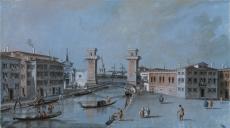


Giacomo Guardi was the pupil of his father, Francesco Guardi, and his most devoted disciple. He shared his father’s prolificacy and is currently ascribed a very large body of work, almost certainly too large, his oeuvre being in need of definition. On the one hand, he should probably be credited with a significant number of paintings and drawings currently attributed to Francesco; the frequent difficulty in discerning between the two is a tribute to Giacomo’s abilities. On the other hand, he should be spared responsibility for many of the pale imitations of his father’s work which are currently labelled with his name. Almost nothing is known of other close associates of Francesco; even in the case of Francesco’s brother Niccolò (1715-1785), a painter of repute in his day, not a single certain work is known.
Giacomo’s relatively long career stretched far into the 19th century, and he was faced, even more than his father had been, with the challenges of adapting the thoroughly 18th-century genre of view painting for a clientele for whom the Grand Tour was a distant memory. By the time that Giacomo came of age, there was rarely much point in producing finely executed and large-scale Venetian views to try to attract the sort of patrons who would earlier have turned to Canaletto, as Francesco had done, mostly in the earlier part of his career as a vedutista. Most of Giacomo’s work is on a small scale, and much of it is on paper. With the different demographic of the 19th-century visitor to Venice, he chose quantity over quality in order to make his work affordable by a much less affluent type of client.
Giacomo’s work on paper sets him apart from his father and reveals a distinct artistic personality in a way that his oil paintings rarely do. The unrivalled collection of his drawings in the Museo Correr in Venice includes a series of 68 rough sketches of Venice, many of them of remote parts of the city which were neglected by other artists. Most individual amongst the works he produced for sale are the tempere, of which the four in the A. G. Leventis Collection are fine examples. Giacomo was able to produce these in large numbers, and they vary significantly in quality. As souvenirs economically accessible to almost any visitor to Venice, they are the direct antecedents of the modern picture postcard, although direct repetition is avoided, as can be can seen in the two variant views of the Island of San Giorgio Maggiore under consideration here. Giacomo showed the figures in contemporary dress, with prominent stovepipe hats and tailcoats, which helps to give them a fully 19th-century character. Although it has been claimed that there are no signed works by the artist, these are often not only signed but inscribed with Giacomo’s address at Calle del Peruchier 5245 (as are three of the examples here), presumably so that prospective clients could find him. They are thus, in fact, the only works for which his authorship is indisputable. The form of the signatures as Giacomo de Guardi shows that the painter was (like his father) proud of the family’s noble origins.
There are several contemporary references to Giacomo’s production of tempere. In 1816, for example, Lady Murray noted in her journal that, ‘Borsato paints views of Venice in the style of Canaletto, the perspective is excellent but he wants the breadth of touch which distinguishes the works of that great artist Gardi [sic]; the son of the painter of that name does views in distemper in the same style.’ On a visit to Venice in 1828 the Hon. George Agar-Ellis, later Lord Dover, acquired from a dealer called Giacomo Tarma no fewer than 96 oils attributed to Guardi, and 14 small paintings in tempera; the latter were surely the work of Giacomo, and probably many of the former as well.
He was the son of the painter Francesco Guardi (see above), and, although he continued in his father’s manner, he was not as successful as him. Most of his paintings are small views of Venice, and he prolonged the Venetian view-painting tradition into the 19th century.